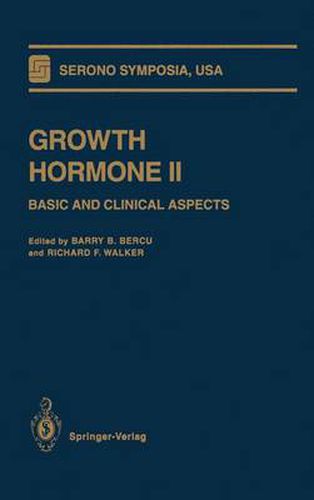Readings Newsletter
Become a Readings Member to make your shopping experience even easier.
Sign in or sign up for free!
You’re not far away from qualifying for FREE standard shipping within Australia
You’ve qualified for FREE standard shipping within Australia
The cart is loading…






This title is printed to order. This book may have been self-published. If so, we cannot guarantee the quality of the content. In the main most books will have gone through the editing process however some may not. We therefore suggest that you be aware of this before ordering this book. If in doubt check either the author or publisher’s details as we are unable to accept any returns unless they are faulty. Please contact us if you have any questions.
This book is a compendium of proceedings from the Symposium on Growth Hormone II: Basic and Clinical Aspects. The intent of the sym posium was to review current aspects of the rapidly expanding science of growth hormone (GH) neuroendocrinology, especially those develop ments that occurred since our last meeting in 1985. The meeting was timely since there have been many new and exciting developments in basic research on the GH axis, and several new clinical applications for GH other than growth have been identified. For example, significant strides have been made into use of the bioengineered hormone as an anabolic in debilitated states and as an immunorestorative agent. Both these areas have received most attention as they relate to geriatric popu lations. Furthermore, recent focus on a novel family of GH secretagogues that complement the action of GHRH has shown that in animal models, these compounds have the potential to restore GH secretion in deficient or insufficient states, including growth retardation, obesity, and aging. Accordingly, these xenobiotics may have significant potential as drug products to stimulate physiological GH secretion and, thus, resist or reverse some of the maladaptive changes in form and function resulting from GH insufficiency. The importance of these agents as drug candidates is underscored by the diversity of molecules that have been studied by various pharmaceutical companies and the recent discovery that non peptide analogs with high oral bioavailability can be synthesized.
$9.00 standard shipping within Australia
FREE standard shipping within Australia for orders over $100.00
Express & International shipping calculated at checkout
This title is printed to order. This book may have been self-published. If so, we cannot guarantee the quality of the content. In the main most books will have gone through the editing process however some may not. We therefore suggest that you be aware of this before ordering this book. If in doubt check either the author or publisher’s details as we are unable to accept any returns unless they are faulty. Please contact us if you have any questions.
This book is a compendium of proceedings from the Symposium on Growth Hormone II: Basic and Clinical Aspects. The intent of the sym posium was to review current aspects of the rapidly expanding science of growth hormone (GH) neuroendocrinology, especially those develop ments that occurred since our last meeting in 1985. The meeting was timely since there have been many new and exciting developments in basic research on the GH axis, and several new clinical applications for GH other than growth have been identified. For example, significant strides have been made into use of the bioengineered hormone as an anabolic in debilitated states and as an immunorestorative agent. Both these areas have received most attention as they relate to geriatric popu lations. Furthermore, recent focus on a novel family of GH secretagogues that complement the action of GHRH has shown that in animal models, these compounds have the potential to restore GH secretion in deficient or insufficient states, including growth retardation, obesity, and aging. Accordingly, these xenobiotics may have significant potential as drug products to stimulate physiological GH secretion and, thus, resist or reverse some of the maladaptive changes in form and function resulting from GH insufficiency. The importance of these agents as drug candidates is underscored by the diversity of molecules that have been studied by various pharmaceutical companies and the recent discovery that non peptide analogs with high oral bioavailability can be synthesized.